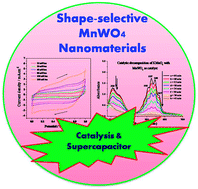Shape-selective formation of MnWO4 nanomaterials on a DNA scaffold: magnetic, catalytic and supercapacitor studies†
Abstract
A new route for the aqueous phase synthesis of single crystalline, shape-selective, magnetic MnWO4 nanomaterials on a DNA scaffold has been reported. The synthesis was done by the reaction of MnCl2·4H2O with Na2WO4 in DNA within five minutes of microwave heating. The process exclusively generates wire-like, flake-like and rice-like morphology just by tuning the DNA to Mn(II) salt and WO42− ion concentration and changing other reaction parameters. The field-cooled (FC) and zero-field-cooled (ZFC) magnetization study reveals that the flake-like structure shows the highest magnetization at 5 K compared to that of the wire-like and rice-like structures. The potential of the shape-selective MnWO4 nanomaterials has been tested in two different applications, firstly in a catalysis study for the decomposition of toxic KMnO4 and secondly in electrochemical supercapacitor applications. It was found that the MnWO4 nanomaterials showed different specific capacitance (SC) values for the various shapes and the order of the SC values is: wire-like > flake-like > rice-like. The highest SC of 34 F g−1 was observed for MnWO4 having wire-like shape. The yields of the products with uniform shapes have been found to be significantly high and the synthesized materials are stable for more than six months under ambient conditions. The present work will find a new platform for the generation of other mixed oxides using bio-molecules as scaffolds at low temperature and in short time scales. Moreover, the synthesized material might be useful for other potential applications in the fields of catalysis, sensors, energy storage materials and so on.


 Please wait while we load your content...
Please wait while we load your content...